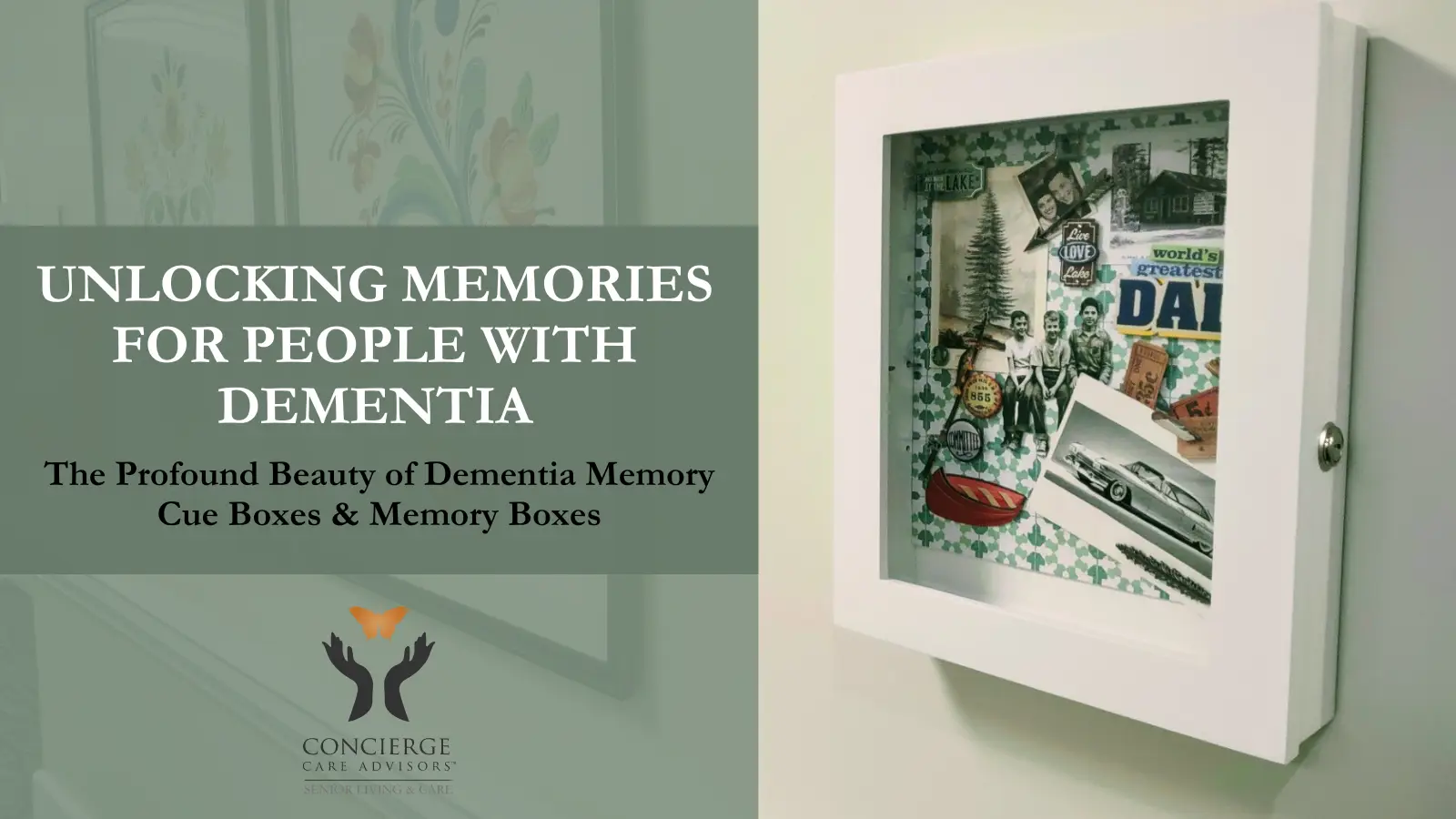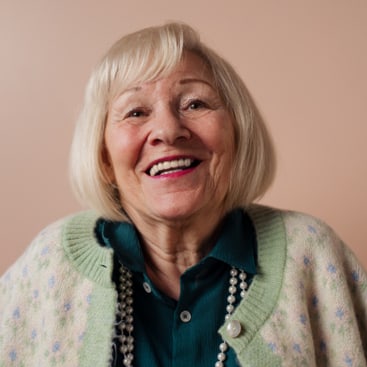By Jennifer Melville, Director of Marketing at Concierge Care Advisors
The Profound Beauty of Dementia Memory Cue Boxes & Memory Boxes
Each month, our company gathers for an all-staff meeting at a retirement community in the greater Seattle area. As someone who works remotely most of the time, I look forward to these opportunities—not only to connect with my team but also to learn more about the senior care industry through guest speakers and to tour a new community each time.
This October, we were hosted by Aegis Living in Ballard, a stunning Assisted Living and Memory Care community in Puget Sound. The brand-new retirement community perfectly blends Northwest chic with Scandinavian heritage, and while I couldn’t get enough of the decor (I would love their interior designer’s help in my own home), there was one feature on the Memory Care floor that deeply resonated with me.
Next to each resident’s door, beautiful shadow boxes hung on the walls.
As a lifelong scrapbooker, these boxes reminded me of the memory books I’ve created for my family or the shadow boxes I’ve put together to honor my husband’s military service. Intrigued, I asked the Senior Living Advisors on our team about them.
They explained that these Dementia Memory Cue Boxes serve as personalized door markers for Memory Care residents, helping them recognize their room while offering a glimpse into their life stories. Each box typically contains a mix of photographs, keepsakes, and other personal memorabilia. As someone new to the senior living industry this was a novel concept to me—one that felt both profound and personal.
A Glimpse into a Life: The Power of Memory
While some of the boxes at Aegis Living were placeholders for future residents, the symbolism was clear. These boxes not only serve as navigational aids but also as conversation starters and portals into the residents’ memories. Look at this stunning example:
I couldn’t stop thinking about it after our tour—what stories could a Memory Cue Box tell? What memories could it unlock?
Here was my interpretation of the Sample Memory Cue Box above:
1959 Cadillac Fleetwood
By Jennifer Melville
A box full of memories hangs by my door,
Familiar yet fading, like mist over the lake.
Inside, three boys—smiling, full of life—
That’s me in the middle—10 years old, strong,
Back when the world stretched out wide,
And the adventures we shared seemed endless.
I remember the cabin, nestled in the trees,
Summer nights melting into laughter,
The scent of pine, smoke from the fire,
How the stars above never dimmed,
And the campfire always felt like home.
I met her there one summer,
And I’ll never forget her smile.
I was 17, she was 16,
And when our eyes met, I knew.
“The best memories are made at the lake,”
And we made ours—young, fearless,
In a world where love was new,
Where everything seemed so simple.
Forty years, three sons later,
What I wouldn’t give to see her smile again,
To feel that moment once more,
Her hand nestled in mine,
As we drove, carefree, the wind in her hair,
In my ’59 Cadillac Fleetwood.
Memory is strange and fleeting.
Yesterday slips away like smoke,
But my youth—it clings to me,
Clear as the rumble of that engine,
Echoing from somewhere deep inside.
What is a Dementia Memory Cue Box?
A Dementia Memory Cue Box (or Shadow Box) is a tool designed to help individuals with dementia maintain a sense of familiarity and connection to their identity. These boxes are personalized with meaningful items from the resident’s past or daily life. Items such as photographs, letters, and trinkets evoke memories and provide a visual and tactile connection to their personal history.
Memory Cue Boxes are often used in Memory Care settings, and they can be incredibly powerful in triggering positive emotions, fostering conversation, and reducing anxiety. By decorating their shadow boxes with personal memorabilia, residents not only enjoy sharing their stories with visitors but also experience a sense of homecoming each time they approach their room. They also help discourage residents from entering the wrong room by accident.
What Items Could You Put in a Dementia Memory Cue Box?
Creating a Memory Cue Box is a deeply personal process. The items should be meaningful to the individual and designed to evoke memories that bring comfort. Consider including:
1. Photographs– Family, friends, pets, or places of significance.
2. Letters or Cards – Handwritten notes from loved ones.
3. Keepsakes or Mementos – Items like a wedding ring, medals, or souvenirs.
4. Books or Magazines – A favorite book or Bible.
5. Textiles – A favorite scarf or fabric with sentimental value.
6. Music – CDs or tapes with songs from their youth.
7. Old Documents – Copies of marriage certificates or diplomas.
8. Hobby-Related Items – Tools that reflect their pastimes.
9. Cultural or Religious Symbols – Rosaries, prayer beads, or cultural artifacts.
10. Art or treasures from grandchildren!
These personal treasures can help residents feel connected to their past, improving their overall sense of well-being.
What is a Dementia Memory Box?
If your loved one doesn’t need a room marker but could benefit from a collection of sentimental items to trigger memories and conversations, a Dementia Memory Box might be the perfect solution. These boxes are filled with cherished mementos—photos, keepsakes, favorite books—that encourage reminiscing and promote emotional well-being. What specifically you put inside depends on your loved one, their temperament, memories, likes, and desires, so work closely with them to collect items that will highlight the best and most enjoyable moments in their life. Your box’s content will be as unique as they are.
Here’s a great article from Cedar Hill Continuing Care Community about how to create one and a photo of an example from their site:
Photo Credit: Cedar Hill Continuing Care Community (https://www.cedarhillccc.com/helpful-resources/make-memory-box-dementia/)
Any box can be used—a shoe box, a decorative box, or any box you choose together. What matters most are the items inside; These items must have personal significance and be chosen to celebrate and commemorate special moments in your loved one’s life.
What Do You Put in a Dementia Memory Box?
What you put inside a Dementia Memory Box depends on your loved one, their temperament, memories, likes, and desires, so work closely with them to collect items that will highlight the best and most enjoyable moments in their life.
The items you select when creating a memory box will be similar to those listed above, though you may choose to include more tactile options. Some ideas include:
- Photographs of family members, friends, or significant life events
- Keepsakes like medals, jewelry, or awards
- Letters or postcards from loved ones
- Books or music that were meaningful to them in the past
- Scented items like perfumes, soaps, or flowers that evoke memories
- Textured objects that feel familiar, such as fabrics or a favorite scarf
- Hobbies or interest-related items (e.g., a golf ball for someone who enjoyed golf)
- Artwork from children or grandchildren
- Children’s favorite toys or baby clothes
- Tickets from important events, playbills
- Gifts from loved ones
How Does a Memory Box Help People with Dementia?
Whether you create a Dementia Memory Cue Box or a Dementia Memory Box, these meaningful treasures help individuals with dementia recall the people and events from their past. Often, it’s easier for those with memory loss to recall events from their youth, and familiar items like a ring, the smell of a favorite perfume, a special holiday card, or the photo of a loved one can bring back memories and feelings of joy.
This article by Veritas Care in the UK lists a handful of reasons why Memory Boxes are beneficial, including:
- They provide mental and emotional stimulation for our loved ones.
- Talking to people with dementia and Alzheimer’s disease about their lives can reduce stress, stimulate well-being, eliminate apathy and depression, trigger a positive emotional experience, and provide a better quality of life.
- It’s a morale booster that creates a wonderful opportunity for conversations and bonding.
- A Memory Box can make your loved one feel more at ease.
Memory is such an interesting thing. My paternal grandmother had Alzheimer’s in her later years, and one of the few things she brought with her to hospice was a beautiful family tree quilt her daughters-in-law had sewn for her with photos, names, and dates. She had it proudly displayed on the wall by her bed just as she had in her living room for so many decades, and she loved to talk about the people and places she remembered every time I visited her. Even as her world so quickly changed and her memory failed her, that quilt and the memories it held wrapped her with comfort. It was her Memory Box.
For more activities to do with a parent or another loved one with Dementia, check out this blog post. If you’d like to talk to a Senior Living Advisor on our team about Memory Care options or support, please contact us. We’re here to help.

























